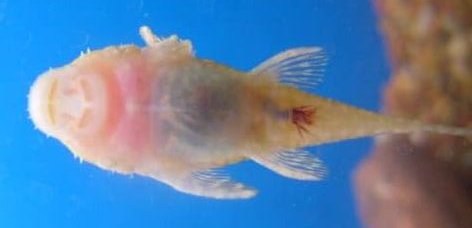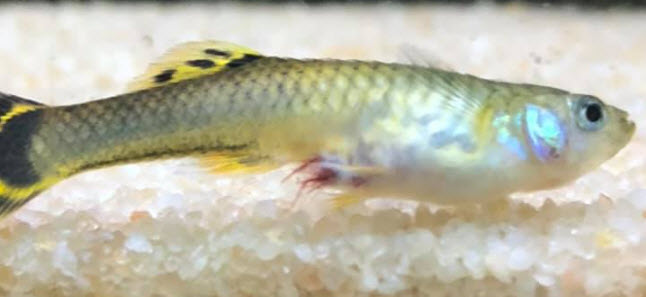Camallanus nematode worms are among the most commonly encountered internal parasites for aquarium fish and may infect a wide range of fish species. They are seen as red threads hanging out of the anus of the fish. Camallanus is often found in necropsies of cichlids which have shown such symptoms as bloat, white poop and not eating. It thus imitates hexamita. Capillaria can also cause hollow belly, arched back, wasting, spitting out food and intestines popping out
Camallanus worms can ONLY be effectively treated by adding fenbendazole or levamisole mixed into the food and ONLY mixed into food. That way you paralyze the worms inside the fish. Medication in the water only paralyzes the worms hanging out of the fish. Medication in the water does nothing to the worms inside the fish. This is why people say the camallanus keeps coming back after treatment.

Camallanus in Depth
Camallanus is a genus of parasitic roundworms (nematodes). The Camallanus cotti species is unique in that it is the only Camallanus worm that doesn’t require an intermediate host. These worms reproduce by producing live offspring since the females incubate the eggs while they are in their bodies to produce the larvae. These larvae are passed out in the feces where they are ingested by other fish.
Camallanus cotti is typically reddish brown. But there are pictures of white nematodes hanging out of the anus of tropical fish. What nematode species these worms are is not clear.
There is a “myth” that fish get camallanus by eating bloodworms. Bloodworms are the larvae of an insect, a midge, and categorically do not have any parasites or eggs of camallanus in them. Nor do tubifex worms spread camallanus. Live cultures of bloodworms or tubifex worms can have pests like leeches among them. So it is not recommended to use live bloodworms or tubifex worms.

What has to be emphasized is that scientists are constantly finding new di-genetic and tri-genetic nematodes which have different intermediate hosts. So the blackworms or tubifex worms MIGHT POSSIBLY have some species of nematode in them which can infect fish in turn. By the same token, there MIGHT POSSIBLY be some species of nematode worm which can use aquarium snails or shrimp as intermediate hosts. But there are no such species found in the literature.
Light infections of camallanus worms are difficult to detect. Serious infections can be indicated by the presence of red, thread-like worms emerging from the anus of the aquarium fish. These are the females releasing their larvae into the water. If a fish is swollen but eats well, suspect camallanus. Long-standing chronic camallanus can give a hollow belly appearance because the intestines become compromised and can’t absorb food.
Well-maintained fish may be infected without exhibiting any symptoms at all, and camallanus worms are commonly found among wild fish without any obvious link between infection and mortality. But negative environmental pressures such as high bacteria count in the water will reduce the immune response of infected aquarium fish, making it easier for the worms to multiply and cause damage to their host fish.
Livebearers seem to exhibit higher mortality due to camallanus and a tank of only livebearers can be wiped out by camallanus.

Treating Camallanus
One must treat camallanus by adding a dewormer to the food. It is a myth that adding medication to the water of the aquarium will cure camallanus. This myth is propagated by medication manufacturers who recognize that their profit will be much greater if one adds large amounts of medication to the water in the aquarium.
Fenbendazole (Thomas Labs Fish Bendazole, Panacur and Safeguard for dogs, and several livestock dewormers) is the most effective medication. It is the medication of choice for camallanus by public aquariums (Hadfield, 2011). Public aquariums use Fenbendazole ONLY in the food. They do not put it in the water.
Levamisole is also an effective medication if mixed into the food. Fritz Expel-P is levamisole. Levamisole can also be purchased at Amazon, subaquaria .com, and Valleyvet .com. Some eBay sellers supposedly sell bogus products, look for cattle products such as Agrilabs Prohibit Soluble Drench Powder and DURVET Levamed Soluble Drench Powder Dewormer.

Other medications supposedly effective against roundworms are Pyrantel Pamoate, Flubendazole (Kusuri Wormer Plus), Ivermectin, and Piperazine. In some countries, this is all that is available to aquarium hobbyists. All are mixed into the food at roughly a 1 to 5% level. This is just a tiny amount of medication, like the size of barley grain, mixed into two tablespoons of food.
Most medications do not kill the worms, they only paralyze the barbed jaws that the roundworms hold onto the gut. So, the detached but live worms get pushed out of the gut and into the aquarium (which the aquarist will see when the pink or red worms emerge and detach from the anus). Within 24 hours of medicating the substrate should be thoroughly cleaned to remove the worms.

The best situation is to transfer the fish to a bare-bottom hospital tank. That way the worms which are paralyzed can be easily seen and vacuumed up. If the fish eat the adults the adult is killed but there can be live larvae inside the adults which can reinfect the fish.
The life cycle of camallanus is relatively long. The larvae can exist outside a fish for three weeks and the worms take three to four weeks to mature once inside the fish. Feed fish with Fenbendazole in the food once every two weeks for at least one month (I do three months).

Fenbendazole, levamisole, pyrantel pamoate, flubendazole, Ivermectin, and piperazine are FDA-approved for use in humans, so they are very safe and effective in food at the 1% to 10% level. These medications are also typically very selective, meaning they only affect nematode worms.
Note that the cautions about deaths of snails, shrimp and invertebrates is very dose dependent. Fenbendazole are often used with no snail deaths because the dosage isn’t high enough. Conversely using a very high dosage of fenbendazole can possibly kill shrimp. And Levamisole is safe for everything except nematodes. Praziquantel is safe with everything except planaria and flukes.
It is easy to make medicated food. Heat 1/4 cup of water (two ounces or 58 milliliters, not a lot) in the microwave. Then blend one 1/4 ounce of plain animal-derived gelatin (Knox gelatin, one envelope) into the hot water with vigorous stirring. Take two tablespoons of dry commercial fish food (pellets or flake) and mix it with just a little of the hot water/ gelatin mixture. Add hot water/gelatin until you get a paste-like consistency. If it gets too watery just add more food.

Then add roughly 1/16 teaspoon (a 1% to 2% addition, the size of a barley grain) of the medication to the mud. Mix and mash the whole mass thoroughly. Spread it out into a pancake about 1/8th inch (3 mm) thick on a plastic film or a plate. Then put it in the refrigerator. If you plan on keeping it for more than two weeks put it in a small plastic bag and freeze.
Note while the fish won’t eat it like they normally do, they typically will eat some if you just leave it in the tank. Also, note that API General Cure and Praziquantel do not work against camallanus. Note this gel food is 80% water. So it will require ten eyeballs per day of food per fish (six fish = 60 fish eyeballs = six times ten).
| Type of worm | Examples of this Phylum | Selective Medications | Non-Selective Medications |
|---|---|---|---|
| Flatworms | Flukes | Praziquantel in Water & Food | Fenbendazole in Water & Food |
| Flatworms | Tapeworms | Praziquantel only in Food | Fenbendazole only in Food |
| Roundworms nematoda | Camallanus Capillaria | Levamisole only in Food | Fenbendazole only in Food |
| Praziquantel does not kill snails or shrimp Fenbendazole and Levamisole kill snails but not shrimp |
|||
Mode of Medication Application
Many people say only levamisole is effective against camallanus. They are incorrect. Fenbendazole is not soluble in water so it does nothing when added to the water, including not making the camallanus worms sticking out of a sick fish’s anus release their hold. Levamisole is soluble in water so it does make the worms sticking out the anus release their hold when it is put in the water of the aquarium. So many well-intentioned commentators on social media vehemently claim only levamisole works.
Some authors have said that Levamisole works great when added to the water. They say that Levamisole is absorbed through the skin and the gills. This is simply not true. The Levamisole molecules are far too large to be absorbed through either the skin or the gills. It just is impossible.

The origins of this thinking are quite simple. Camallanus worms stick their bodies outside the anuses of the fish to release their larvae. So levamisole in the water column is easily absorbed by the worms sticking out the anus directly from the water. The worms become paralyzed and fall out of the anuses. So the fish then APPEAR cured.
But ONLY the worms sticking into the water were paralyzed. The worms remaining in the fish were not paralyzed. Whether or not the infection “re-occurs” (actually whether or not the worms still in the fish stick their bodies out the anus) is dependent on a raft of variables including the health of the fish and the size of the infestation.

This lack of understanding of the way medications work is reflected in the often heard “But I treated for camallanus over and over again and it just keeps coming back!” These hobbyists are invariably putting the medication into the water column, not into the food.
Internal fish diseases such as camallanus can ONLY be truly treated in the food. Adding medication to the water is useless (but it makes a lot of money for suppliers!). Many believe (and the instructions on the dewormers say!) that fish medications need to be added to the water. They are simply incorrect. This controversial topic is covered in the following link:


